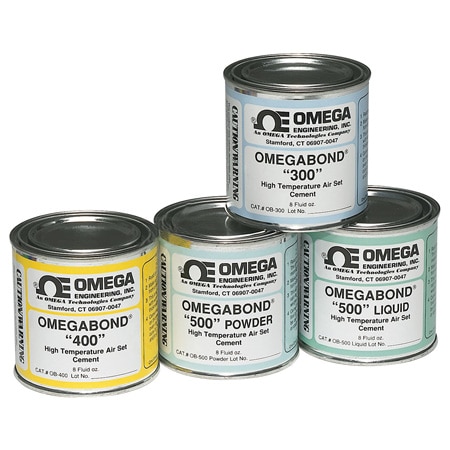1-800-663-4209 | Your feedback matters, take a quick survey Website Feedback

OB-OMEGABOND-AIR-SET
Air Set High Temperature Cements
Models In Stock
- Thermally Conductive
- Thermal Shock Resistant
- Electrically Insulating
- Resists Oils, Solvents, Most Acids
OB-OMEGABOND-AIR-SET
From
$
67.64
Models In Stock
Product Overview
- Dielectric Strength Note Dielectric Strength at 20°C:12.5 to 51.0 V/mil;Dielectric Strength at 400°C: ≤15 V/mil;Dielectric Strength at 795°C: ≤1.3 V/mil
Air Set Cements set or cure through loss of moisture by evaporation. Atmospheric conditions therefore affect the drying rate. Air Set Cements are used mainly in thin film applications (applied in thicknesses less than 1/4")*.
SELECTION CRITERIA FOR CEMENTS
1. Type of Application † “ Potting, sealing, encapsulating, assembling, bonding. Is a thick or thin film of cement required? This dictates whether or not an air set or a chemical set cement should be used.
2. Thermal Considerations † “ What is the maximum temperature that the cement must withstand? What degree of thermal conductivity is needed? What degree of thermal expansion is allowed? These parameters are then matched to the appropriate cement.
3. Substrate † “ What materials will the cement be in contact with?
4. Application Considerations † “ Pot life, set time, method of dispensing, batch size, cure procedure.
5. Miscellaneous Considerations † “ Porosity, moisture absorption, electrical resistance, volume stability, clearances/tolerances.
SELECTION CRITERIA FOR CEMENTS
1. Type of Application † “ Potting, sealing, encapsulating, assembling, bonding. Is a thick or thin film of cement required? This dictates whether or not an air set or a chemical set cement should be used.
2. Thermal Considerations † “ What is the maximum temperature that the cement must withstand? What degree of thermal conductivity is needed? What degree of thermal expansion is allowed? These parameters are then matched to the appropriate cement.
3. Substrate † “ What materials will the cement be in contact with?
4. Application Considerations † “ Pot life, set time, method of dispensing, batch size, cure procedure.
5. Miscellaneous Considerations † “ Porosity, moisture absorption, electrical resistance, volume stability, clearances/tolerances.
PDFs & Manuals
Show Ratings & Reviews
Rated 1 out of
5
by
Bree from
Doesn't bond to Ready-Made Thermocouples
For whatever reason this stuff does not bond to the Ready-Made ThermoCouples. It bonds to metal just fine.
Forwarded concerns on this issue.
"There are only a few possibilities – The mixture is not correct; the curing time is not sufficient or there has not been enough applied. An outside possibility is the material is no longer viable" ?????
"We let it sit over the weekend. It seems to have set up good. There was some left over in the cap we mixed it in and it was hard as a rock. It just isn’t bonding to the wire. There was plenty applied.
Material is not viable as in the bonding agent is possibly bad? Sticker on it says use before 3/2018"
No response after that...... Had to figure something else out.
Date published: 2017-06-02
Rated 1 out of
5
by
Ryan Essenmacher from
Issues with mixing and curing.
Unclear mixing instructions, susceptible to oil even at low temperatures (40°C), and doesn't like to stick to Kapton surface mount thermocouples. You need to apply pressure during the cure and rough up the surface for any hope for it to bond to the Kapton surface mount thermalcouples. I won't be purchasing this 1 part cement again, going with a 2 part for hopefully better results.
Date published: 2024-07-23
Rated 5 out of
5
by
Devin H from
Amazing product!
I am using this to attach an aluminum heat sink to an IC on some circuitboards. The thermal conductivity is amazing. It performs just as good as a high quality thermal epoxy, but it's easier to work with. I followed the instructions in the data sheet and it becomes rock hard when fully cured.
Date published: 2023-11-20
Rated 1 out of
5
by
Manu khod from
Doesn't work at high temperatures
I had bought OB700 and OB400 and they are claimed to be working at high temperatures.
Unfortunately, they are a waste at high temperatures (500-600C) and lose strength like anything. As soon as i bring them to room temperature, they offer some strength.
Clearly, they are not high-temperature cements. They are just regular ceramic powder grounded.
Date published: 2022-01-17
The inst. for using OB300 specifies three steps for "optimal performance". 1. Dry18-24h RT. Is there benefit of 24 vs 18? 2. What is benefit of 4h 82C? 3. What is benefit of 4h 105C?
Hi LouisL,
Thank you for the inquiry. These are described as additional steps after room temperature curing. And for cases where cement is to be exposed to elevated temperatures above ambient. The additional steps help prevent flaking and chipping.
Best regards
OMEGA
Date published: 2023-04-28
I am looking at sticking a thermocouple to a kapton heater. Will Omegabond 300, 400 or 500 stick to that material?
Our Omegabond 400 would be best as it has the highest thermal conductivity.
Date published: 2021-08-28
I want to seal an end of a stainless steel tubing, with this product additionally the product should withstand when the tube is at 600 degrees Celsius and at 3-4 bars pressure. Will this product be suitable?
The OB-300 maximum service temperature is 982C so that is fine. We do not put any pressure specifications for a seal so that would have to be tested in the customers application to see if it works.
Date published: 2024-11-23
I'm wondering what the thermal conductivity of Omegabond 500 is. I can't find it in the datasheet.
Thank you for your inquiry. The OB-500 has an undefined thermal conductivity.
Date published: 2021-08-27
I want to put smaller rock on the harth of my fire place will this product work for this
The material would hold a small object provided it would not be exposed to temperatures above the maximum rating.
Date published: 2021-08-28